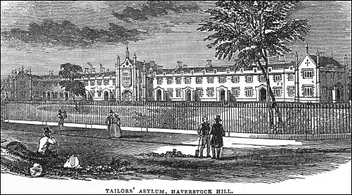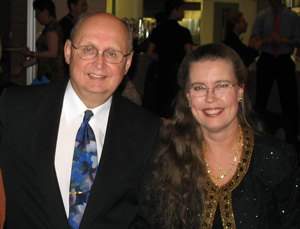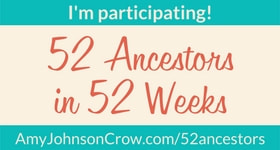John GREEN, Terry’s 3-times-great grandfather, was born about 1796 in Surrey England, the son of John GREEN senior, the shoemaker. John married Mary Ann in about 1814; we do not know her maiden name. We believe they had six children. I have already talked about their oldest daughter Mary Ann GREEN (1816-1862) who had 14 children with her husband Thomas BOORMAN in Wandsworth, Surrey (now part of London). I'd now like to tell the story of her GREEN ancestors.
John GREEN is a very common name. The number of associated records on ancestry is close to 3 million, so research on this line has been a challenge. Fortunately we have a short compiled family history document written in the early 1950s by Caroline Winifred DYER, the great-granddaughter of John and Mary Ann GREEN, and the granddaughter of Thomas BOORMAN and Mary Ann nee GREEN. Although she doesn’t list her GREEN ancestors' full names, Winifred's memoirs have given us first hand knowledge of their character and situation. These colorful clues have allowed us to piece together the bigger puzzle with greater certainty. Winifred writes from her own perspective, starting with her BOORMAN / GREEN grandparents [I have inserted names in the following excerpts for clarity]:
... Before long [grandfather Thomas BOORMAN] became acquainted with Mary Ann GREEN, whose father was a tailor in Wandsworth High Street. She was one of a family, and I think she was probably the eldest. She certainly had two younger sisters, both still living in Wandsworth till I was pretty well grown up. They were Aunt Hannah GREEN and Aunt Adelaide BERRYMAN. Grandmother had also a younger brother, Uncle Fred [GREEN], who went off to Australia as a young man, but was never heard of again, and was believed to have been lost at sea on his way out.
Grandmother Boorman [Mary Ann nee GREEN] was well educated, having been to the best school in Wandsworth at the time. The large house where she went to school was still standing when I was a child and had an observatory on the roof. She learnt French, and I had, as a child, the French Grammar book which she had used at school and which had been handed down to my mother. One of the subjects in the school curriculum was described as ‘Geography and Use of the Globes, Terrestrial and Celestial’. When crinolines came into fashion she set herself strongly against them and could not be persuaded to wear one, although they were so universally worn at that time, that she looked quite conspicuous without one. She was good and affectionate and kind, but a little inclined to be sarcastic. She always addressed her husband as “My dear” and he always addressed her as “My love”.
Great-grandfather Green [John GREEN] was a cheerful and chatty man, small of stature, and in the habit of smoking a long Churchwarden pipe in the evenings. Great-grandmother [Mary Ann] Green must, I think, have died before the younger daughters were grown up, or certainly while they were still at home, because Great-grandfather Green married again [to a Caroline Phillips] and I have understood that Aunts Hannah and Adelaide did not get on too well with their stepmother. Great-grandfather Green and his second wife ended their days very comfortably in an Almshouse. I think he was a Freeman of the City of London, but I am not clear about that and feel I may be mixing him up with some other story of my Mother’s.
The above family story also mentions Aunt Adelaide BERRYMAN nee GREEN. Indeed there was a marriage of an Adelaide Amelia GREEN to a George BERRYMAN in the Stepney Registration District of London and Middlesex in the June quarter of 1857. George was a widower, working in sales for a tailer in Wandsworth in 1851. He was considerable older than Adelaide who was working for him as a shop woman or servant even before they married. They had one son George who likely died without issue.
 Believed to be the last residence of John and Caroline GREEN.
Believed to be the last residence of John and Caroline GREEN. Courtesy of victorianlondon.org
By 1871, John and and his second wife Caroline GREEN were living on their own at 10 Tailor’s Asylum, St Pancras parish, Kentish Town in London. This facility was built in 1843 by the Tailors Benevolent Institution for the Relief of Aged and Infirm Journeymen Tailors. Each qualifying retired journeyman tailor was assigned an apartment of two furnished rooms, coals and medical attendance, and received a pension of £26 per year (rates as of 1890). Somehow the word “asylum” doesn’t seem the right choice for such a facility. The word “almshouse", used in the family story, is defined by the Oxford English Dictionary as “a house founded by private charity, for the reception and support of the (usually aged) poor”. This seems appropriate for John GREEN’s circumstances, although until now I had incorrectly equated "almshouses" with "workhouses" or "poorhouses", and therefore feared the worst. According to Wikipedia, “poorhouses” were for paupers, mainly elderly and disabled people, who were supported at public expense. They could be associated with prisons or other penal or charitable public institutions. Tailors’ Asylum doesn’t appear to be such a place. I certainly hope that both John and Caroline "ended their days very comfortably" as the family story says.
It is possible that John’s second wife Caroline also died before him. We have found a death registration for Caroline GREEN at the age of 67 later in 1871 in the Pancras district - the most likely death record as both the age and location match, although not yet proven. Seventeen years later, John GREEN was buried on 11 Jun 1888 in Tooting Graveney, Wandsworth, having reached the advanced age of 92. Looking at a map of southern England, both Wandsworth (where John lived and worked as a tailer) and nearby Tooting Graveney (where he was buried) are both south of the winding Thames River and Battersea Park. Haversack Hill (where the Tailors Asylum was located) and the St Pancras parish are north of the Thames and Buckingham Palace near Regent’s Park. I think it possible that John GREEN died while living at Tailors Asylum, but his death was registered in the Wandsworth district in the second quarter of 1888. I don’t yet have his death certificate to clarify the location.
Was this John GREEN a Freeman of the City of London? Such freedom was customarily granted to many who had achieved success, recognition or celebrity in their chosen field. John's working career as a tailor was spent in Wandsworth Surrey, across the river from London. If John's business extended as far as London, and especially if he was a member of the early "Merchant Taylor" livery (trade association) of London, he might have had reason to apply or be nominated for freedom to do trade and vote within the London square mile. More research on this is needed.
In 1851, tailors were the 11th most popular occupation in England, although numbers and ranking decreased in later census, perhaps because of increased demand for cheaper readymade clothing for the growing middle class. We do know that John was a skilled journeyman tailer and received a small tailor's pension and housing in London (away from Wandsworth) upon retirement. He was not a rich man after all his labours. But he lived a long life, and if family stories are to be believed, he was a cheerful and chatty man, deserving of loving family and friends.
GREEN Name Meaning - ancestry site
GREEN and GREENE Surname - surname database site
Occupations in 1851, 1861, 1871 England census - victorian web site
Tailors Benevolent Institution for the Relief of Aged and Infirm - victorian London site
"The Charities Register and Digest", 1890, page 777, Tailors Benevolent Institution - google book
The Almshouse Association - almshouses site
The Workhouse History in England - workhouses site
Freedom of the City of London - city of London site
Livery Company - wikipedia
The Guild of Freemen of the City of London - their guild site
"52 Ancestors" is a reference to the "52 Ancestors in 52 Weeks" challenge I am participating in.
Reference the No Story Too Small blog by genealogist Amy Johnson Crow for more details.
It is giving me the much needed incentive to write and publish my family stories.




 RSS Feed
RSS Feed
